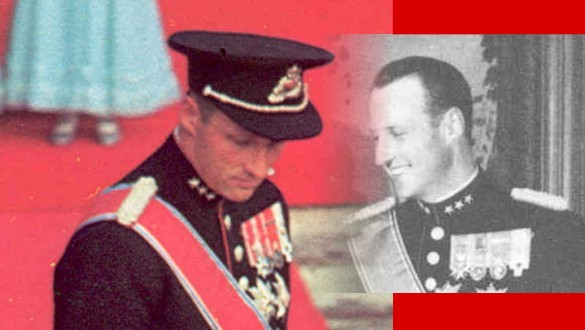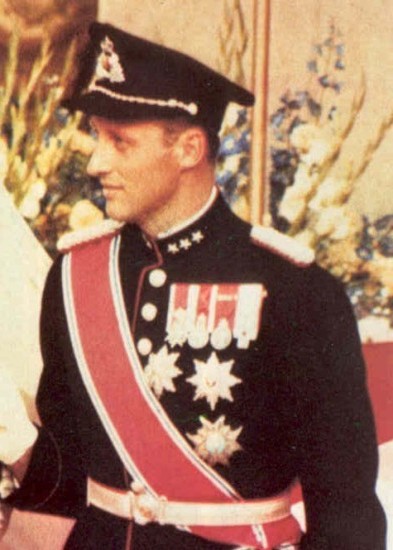

The birth of Prince Harald, third child and first son of Crown Prince Olav and Crown Princess Märtha, on the 21st February 1937 in the Royal Estate of Skaugum, near Oslo, brought great happiness to the Norwegians, for he was the first prince to be born on Norwegian soil in some 567 years. Until the early 1990’s, the law had it that only males could succeed to the Norwegian throne and the only two children of Crown Prince Olav and Crown Princess Märtha were girls, Princess Rahgnild, born on the 9th June 1930, and Princess Astrid, born on the 12th February 1932. Until the birth of Prince Harald, Norway did not have the much-needed male to succeed Crown Prince Olav, after he has succeeded his father, King Haakon, on the young throne. All of Norway rejoiced at the news that an heir was born. Prince Harald was raised at his parents' country estate, Skaugum, in the first few years of his life. That was until the 9th April 1940, when the Nazis invaded neutral Norway, having as their first target the Royal Family.
In the dark of night, the Crown Princess and her young children fled to Sweden, before finally making their way to the safety of the United States, where President Franklin Delano Roosevelt received them. And it was there that they remained for the next five years, until the war was over and Europe was liberated. During those years, Crown Prince Olav and Crown Princess Märtha barely saw each other, since the Crown Prince remained with King Haakon VII in London, where a very strong friendship was built with the British sovereigns, King George VI and Queen Elizabeth. At the end of the war, hundreds of thousands of Norwegians welcomed their beloved Royal Family back from exile as all celebrated Europe's newfound freedom. It seemed, in the Crown Princely family, that happiness would be retrieved, the happiness lost at the beginning of the war. But it was not to be.

On the 21st September 1957, King Haakon VII died and Crown Prince Olav became King Olav V, while Prince Harald became Crown Prince of Norway. King Olav was not crowned – unlike his parents, King Haakon and Queen Maud – but instead instituted the tradition of a consecration and blessing ceremony at Nidaros Cathedral in Trondheim. The surveillance of the Crown Prince’s education became even more important, even if it has always been. His education consisted of normal schooling followed by matriculation at Oslo University. As future Supreme Head of the Armed Forces, Crown Prince Harald attended the Cadet College for Cavalry Officers and the Military Academy. As a complement to his education, and apart of the acquaintance with state affairs, the Crown Prince attended social science, history and economics lectures at Balliol College, in Oxford. As Crown Prince, he attended the Council of State, acted as Regent for King Olav when he was abroad and occasionally represented Norway during official trips through the world.
Crown Prince Harald first met Miss Sonja Haraldsen at a party hosted by a mutual friend, Johan H. Stenersen, in June 1959. Miss Haraldsen had stayed away from all social gatherings after her father Mr. Karl A. Haraldsen died suddenly in early March 1959, and this was the first time after he died she went to a party. When the Crown Prince graduated from the Military Academy in August 1959, he invited her as his date for the graduation ball, and two photographs of them together were taken. From then on, Miss Haraldsen was a “public secret”, and had to learn to live with journalists and photographs that would go quite far to get pictures of her. But Norway and King Olav had desired that Crown Harald would marry a Princess of royal blood (among the whispered names, were those of Princess Benedikte of Denmark and Princess Irene of Greece). Prince Harald, being inflexible that he would marry a woman of his own choice, did not feel the need to heed anything.
The relationship of the Crown Prince and Miss Haraldsen continued for nine years and, in 1968, King Olav announced the couple's engagement. A very heated political debate had been taking place in the kingdom, as many argued about the future of the monarchy. But the couple was given a warm reception and the Norwegians accepted Miss Haraldsen as their new Crown Princess. They married on the 29th August 1968 and celebrated the births of their children, Princess Märtha Louise on the 22nd September 1971 and the male heir Prince Haakon Magnus, whose baptism was a true state occasion, on the 20th July 1973. The Crown Prince and the Crown Princess travelled extensively through Norway and the World, representing the King and Norway from Africa to India, from the USA to Latin America.
King Olav V was not only a respected sovereign, he was truly loved and seen as an unifying symbol of Norway. On the 17th January 1991, King Olav died and Norway mourned for various days. Crown Prince Harald became King Harald V and a few days later, on the 21st January, the new King was enthroned during a ceremony at the Storting. During the ceremony, the King swore allegiance to the Constitution and pronounced a brief speech, in which he said:
“At this first meeting between the people’s elected representatives and me as King, I would like to express the hope that the good relationship which has existed between the Storting and my father, and before him my grandfather, will be maintained and then developed in line with the tasks the country in the future will meet. The Queen and I confirm that we will be devoted to fulfil our mission for the country and people. In the light of this tradition I have, as King of Norway, chosen the motto: All for Norway.”

The new King and Queen made numerous visits in Norway and everywhere they went, large crowds gathered to greet their new monarchs, who have brought the Royal Family somehow closer to the people. The sovereigns have made numerous state visits throughout the world. The King is a well-known sportsman, having sailing as his favourite sport. Photos of him sailing in Palma de Mallorca with the King of Spain have become quite frequent. There is a remarkably good relationship between the Norwegian Royal Family and the other European Royal Families, fiercely exposed during the celebrations of the sovereigns’ Silver Jubilee and 60th birthdays, as well as at the wedding of Crown Prince Haakon with Miss Mette-Marit Tjessem Høiby. The King remains highly respected in Norway, and will, without doubt, find a place in the future, similar to the one his father had, in the hearts of the Norwegians.
